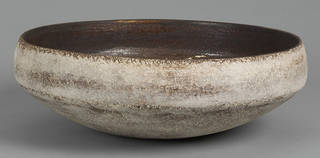The V&A has acquired a rare work by Hans Coper (1920 – 1981), arguably Britain’s most important post-war ceramic artist. The Museum has collected Coper’s ceramics since 1951 and has one of the most important public collections of his work. This stunning bowl joins 12 other examples in the Museum’s collection that trace the artist’s career over three decades.

Hans Coper was a leading figure in the field of studio pottery — the production of unique ceramic wares made by individual artist-potters in small batches. Together with his friend and mentor Lucie Rie (1902 – 1995), he was instrumental in revolutionising British ceramics, adopting a style which was increasingly sculptural. The bowl, newly acquired by the V&A, is an example of his more functional work, which explored traditional ceramic forms. It was made at an earlier stage of his career as a potter, before the sculptural work for which he is best known.


Coper fled Nazi Germany for Britain in 1939, where he was interned as an ‘enemy alien’ and posted to Canada on military service during World War II. On his return to London in 1946, he found work in the studio of Austrian potter and fellow émigré Lucie Rie, despite having no previous experience in ceramics. Rie is responsible for some of the 20th century's most celebrated and recognisable studio ceramics. With her support, Coper learnt to pot, initially as her assistant, but soon producing his own work in her studio in Paddington, which they shared until 1958.
You can visit a reconstruction of Rie's studio in our Ceramics Galleries, complete with her pottery and the equipment used by both Rie and Coper.

Coper soon found his own artistic voice, working with discipline and a restricted range of materials to develop an abstract style, rich in sculptural expression. The newly-acquired bowl is one of a handful of large decorative bowls he made between 1953 and 1955 — an example of his early work, rarely seen in public collections today. It depicts a bird with outstretched wings (perhaps a phoenix) above a sun-like motif. This powerful, simplified design reflects the artist’s dual interest in modern painting and ancient art.


The bowl is now on display in our Ceramics Galleries, close to the original potter’s wheel on which it was thrown. It was purchased in memory of the journalist Annabel Freyberg through the generosity of her friends, with remaining contributions from the V&A.


